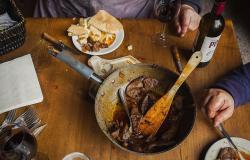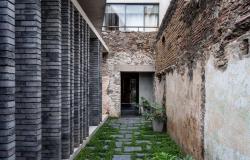PHotoESPAÑA, the great photography event in our country, celebrates its 27th edition with two new features: the absence of Alberto Anaut, founder of the festival in 1988 who died last 2023, and the new direction assumed by María Santoyo after the departure of Claude Bussac after 17 years leading the project. This year the festival returns with 84 exhibitions that bring together the work of 293 artists in different cities in Spain.
Under the motto Perpetuum mobile, Santoyo takes on the challenge with the aim of making the festival ask itself what photography can be. As usual, the central exhibition of PHotoESPAÑA is the one with the edition’s motto as its title. Perpetuum mobile is a group exhibition curated by Alejandro Castellote that can be seen at the Círculo de Bellas Artes in Madrid.
Aware that it is difficult to see all the proposals, we review the ten essential exhibitions of this edition that seek to expand the notion of photography and show the creativity and diversity of visual artistic practice consolidated since the beginning of the millennium, both inside and outside our borders.
Erwin Olaf – Fernán Gómez. Village Cultural Center
Fernán Gómez. Cultural Center of the Village builds in Narratives of emancipation, desire and intimacy a panoramic view of the dutch photographer Erwin Olaf in which it becomes the first posthumous exhibition after his death in 2023 due to a lung transplant. His images are cinematic, delicate and very careful, his protagonists inhabit stylized spaces and, at the same time, transmit sadness. Divided into three sections, throughout the journey the viewer experiences different sensations such as loneliness, lack of communication, isolation, individualism and violencecentral themes in the work of this author recognized for renewing the aesthetics of staged photography.
Elliot Erwitt – Canal Foundation
If you like quality but entertaining photography, Elliot Erwitt’s exhibition is one of those essential events. Great classic of photography that we also lost last year, His work is full of irony, humor and insight. The three sections that make up the exhibition are led by its three great sources of inspiration: people, animals and shapes. With a mind ready to have fun, The human comedy, at the Canal Foundation, proposes a tour of 135 images through which the visitor can understand Erwitt’s words: «For a photograph to be good, it must have balance, form and background. But for it to be very good it must also have an indefinable magic.
Iwan Baan – ICO Foundation
Iwan Baan He is one of the most prominent architectural photographers internationally.. His images, in which he captures the essence of the buildings, but also the life that takes place in them, have taken him to travel around the world. Images of workers working on a building, a move, traditional Japanese houses or portraits officers of the buildings of some of the best-known architects such as Zaha Hadid, Herzog & De Meuron, David Chipperfield or Tatiana Bilbao are the subject of his lens. Moments in Architecture offers a tour of the architecture of the early 21st century contextualized in its urban and social environments.
Consuelo Kanaga – Mapfre Foundation
The Mapfre Foundation has accustomed us to top-level photography exhibitions and this year is no exception. On the one hand, it exhibits the work of David Goldblatt, a South African photographer who portrayed the violence that occurred in the country during the apartheid. On the other hand, it brings together for the first time in Europe the work of Consuelo Kanaga, whose artistic corpus is a criticism of poverty, racial harassment and inequality suffered by the African-American population in the United States.. Kanaga was one of the first women to dedicate herself to photojournalism, but the gender inequality of the time limited her scope and although she strengthened ties with other photographers such as Tina Modotti or Dorothea Lange, her work has not been as represented as that of her colleagues from profession. catch the spirit It aims to break with this oblivion and show the work of “one ahead of her time,” in the words of Dorothea Lange.
Gonzalo Juanes – Canal de Isabel II
In the 20th century, photography in Spain changed with the creation of the magazine Afal, a publication from which one of the most important groups was born with leading figures such as Oriol Maspons, Gabriel Cualladó or Carlos Pérez-Siquier. Also there was Gonzalo Juanes, a photographer who used color and reportage to give us a great fresco of his native Asturias, where he lived much of his life and where he captured the uniqueness of its inhabitants. Furthermore, in 1965 he carried out a work on Serrano Street in Madrid in which he managed to capture the life of the city’s bourgeois class. All of this plus the work done in a more abstract final stage is what can be seen in An uncertain lightthe first retrospective dedicated to his work.
Miss. The beginnings of women’s sports 1915-1936 – Ortega Marañón Foundation
She stood out as a tennis player and skater but there was no sport that could resist Lilí Álvarez (1905-1998), a fundamental figure in the history of Spanish sport. She practiced skiing, mountaineering and motor racing and, in addition, became the first Spanish woman to participate in the Olympic Games: those in Paris in 1924. The Ortega Marañón Foundation participates for the first time in PHotoESPAÑA with this exhibition that not only pays tribute to Spanish women’s Olympics but also to the Residencia de Señoritasin whose life the fundamental figures of the artistic, literary, political, intellectual and social feminine avant-garde participated from its foundation in 1915 until the civil war.
Surrealist Centennial – Leica Gallery Madrid
This year marks the centenary of the publication of André Breton’s surrealist manifesto and many international museums are celebrating the anniversary. On the occasion of the festival, the Loewe Foundation presents at Leica Gallery Madrid surreal centenary, an exhibition that reveals the influence that this movement had on the composition, themes and aesthetics of photography. It is a collective in which we find images of key figures such as Dora Maar, Kati Horna, Berenice Abbott, Graciela Iturbide, Imogen Cunningham, Henri Cartier-Bresson, Man Ray or Philippe Halsman. An exhibition that moves between reality and fiction and plays with the visitor’s perceptions.
Giacomo Puccini – Royal Theater
The Teatro Real is also one of the new venues for the photography festival and does so by showing an unknown facet of Giacomo Puccini, the great Italian composer known for his works Madama Butterfly, Turandot, Nessun dorma either La Boheme. The snapshots he takes in cities like New York focus on buildings, while those he takes in countries like Egypt focus on people rather than monuments. In any case, it is a surprise to learn about this lyrical facet of the opera composer, who also dared to be a photographer who played at portraying his own shadow.
Lúa Ribera – Lázaro Galdiano Museum
Agony in the Garden is the title of the exhibition that Lúa Ribera brings to the Lázaro Galdiano Museum to show contemporary youth movements and reflect on the present. The result of this work, carried out in collaboration with several young people in central and southern Spain, is the portrait of a generation that reflects the hedonism and nihilism of the Spanish scene of trap and drill. «My goal with this work is to read between the lines, reflect on the potential of a dominant expression of our time—often represented as performative or superficial—to explore its richness and how it relates to the current context of job insecurity, institutional violence and migratory, financial and environmental crisis,” said Lúa Ribeira.
Javier Campano – The Eagle
Javier Campano’s exhibition, Neighborhoods. Madrid 1976-1980could not be missing from this list of essentials. With a sharp and elegant gaze, the photographer captured the transformation that Madrid experienced at the end of the 70s, a city afflicted by urban planning and housing problems for the entire population that came to the city from the rural areas of the country. Campano entered neighborhoods such as Orcasitas, Vallecas, Chamartín or Barrio del Pilar where he was able to portray children playing in lots, mud, orchards, donkeys and brick buildings. This exhibition is a sample of the corners of that city and of those inhabitants who opened the doors of their homes to him and made him participate in the neighborhood struggles, a mosaic that is undoubtedly worth a visit to get to know or recognize the city that now we inhabit






